Impacts of the Rugby world cup in New Zealand's macro-economic statistics
Wednesday 4 April 2012, 3:59PM
1170 views
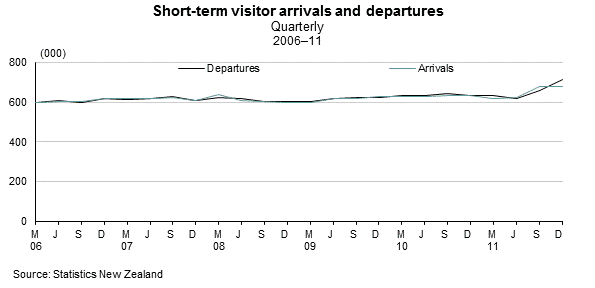
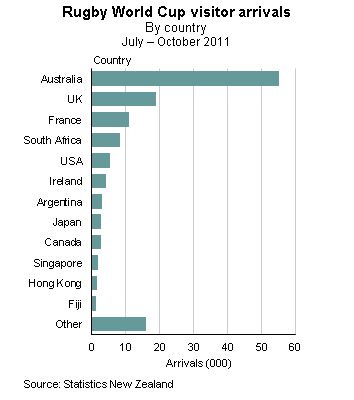
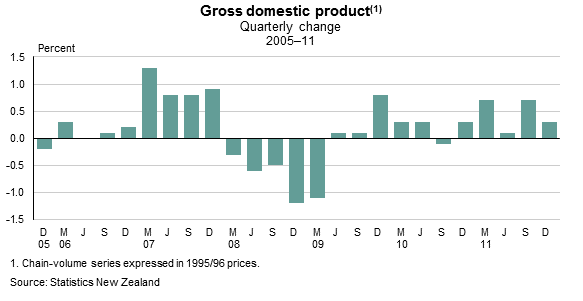
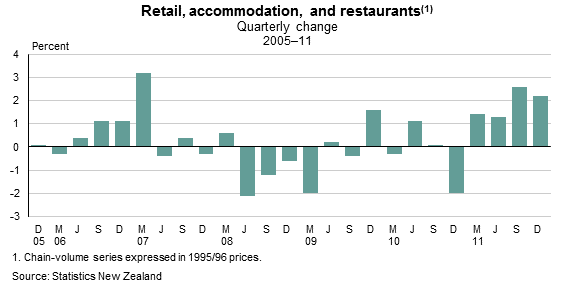
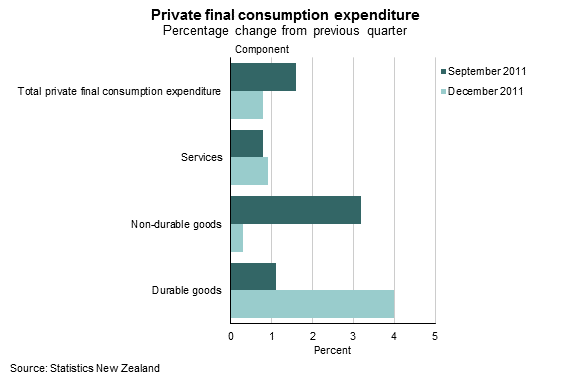
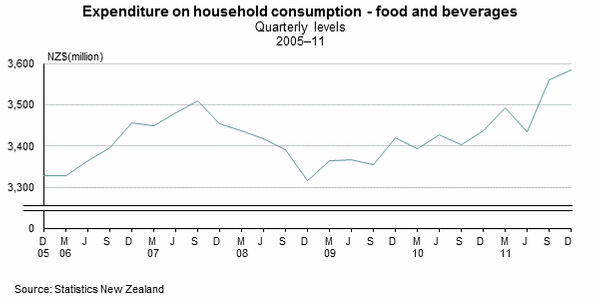
New Zealand hosted the 2011 Rugby World Cup (RWC) from 9 September to 23 October 2011. In this article, we examine how hosting the tournament affected the New Zealand economy. We have analysed migration, accommodation, trade, gross domestic product (GDP) and balance of payments (BoP) statistics to show the effects that hosting the tournament had on different sectors of our economy.
As the tournament spanned the September and December 2011 quarters, we have analysed data collected in both quarters. We looked at:
- how many visitors came to watch the tournament
- how much they spent while here
- how New Zealand and the rest of the world watched the tournament
- how the tournament affected GDP.
Visitor numbers, accommodation bookings, overall spending, and GDP all rose in the September and December 2011 quarters. The RWC may have contributed to these increases. However, it is difficult to separately identify the impact of the tournament.
All BoP figures quoted are in current prices. All GDP figures quoted are chain-volume measures that have price effects removed.
More visitors came to New Zealand to watch the Rugby World Cup (RWC)
International travel and migration statistics on short-term arrivals and departures clearly show an increase in visitor numbers leading up to and during the RWC. As the graph below shows, arrivals increased significantly between June and October 2011.
(See Graph: Short-term visitor arrivals and departures)
Everyone arriving in New Zealand fills out an arrival card, which asks about the purpose for their visit (holiday, business, visiting family). Leading up to the RWC, visitors were also asked whether they were for the RWC. Those who said that they were here for the RWC were classified as ‘RWC visitor arrivals’ in our statistics.
International travel and migration statistics showed that there were 74,400 RWC visitor arrivals in September 2011, and 53,200 in October 2011. In total, there were 133,200 RWC arrivals between July 2011 and October 2011.
All of these visitors needed somewhere to stay. Statistics from the Accommodation Survey show that total international guest nights rose 21 percent in the September 2011 month compared with September 2010. Guest nights also rose 7.1 percent in the October 2011 month compared with October 2010.
Overall visitor numbers were higher than usual in September and October 2011. Most visitors came from Australia, the United Kingdom, and France. However, visitors from Australia also included 3,500 United Kingdom citizens, 2,300 Irish citizens, 900 South African citizens, and 500 French citizens living in Australia. The graph below shows visitor arrivals, by country.
(See Graph: Visitor arrivals, by country)
Visitor arrivals boost transportation exports
When non-residents fly to New Zealand on New Zealand resident airlines, their airfares are captured as an export of transportation services in the balance of payments.
Most RWC visitors arrived in the September 2011 quarter. Seasonally adjusted transportation services exports figures increased $41 million (6.6 percent). Exports of these service decreased $11 million (-1.7 percent) in the December 2011 quarter, but were still higher than previous December quarters.
Visitors spend around $3,400 each
When a non-resident spends money in New Zealand, this is captured as an export of travel services in the balance of payments and national accounts. This includes the amount international visitors spend on internal travel, food and beverages, and accommodation.
The International Visitors Survey, which is based on interviews of tourists leaving New Zealand airports, showed that average spending for adults here for the RWC was around $3,400. If each visitor over the age of 15 spent $3,400, roughly $387 million1 was spent.
In the BoP for the September 2011 quarter, travel exports were $55 million greater than the September 2010 quarter. In the December 2011 quarter, travel exports increased $140 million compared with the December 2010 quarter. In our statistics, spending on travel is attributed to the quarter when visitors leave New Zealand rather than when they arrive. The increase in the December 2011 quarter was expected, because many people left the country when the RWC ended (in the December 2011 quarter).
Seasonally adjusted exports of travel services increased in both the September and December 2011 quarters. Exports increased $75 million (4.5 percent) and $64 million (3.7 percent), respectively. This is an increase of $139 million during the September and December 2011 quarters.
This increase in exports of travel services is lower than the $387 million that we identified as spending directly attributable to RWC visitors. This could be due to a number of reasons, including the following.
- Displacement effect – some visitors who came here for the world cup would have come here anyway. The Ministry of Economic Development (MED) estimates a net increase in spending resulting from RWC visitors alone of between $220 million and $340 million. The MED are currently investigating the impact of the RWC and will release further information in the coming months.
- Natural disasters in New Zealand and key visitor markets affecting the travel decisions of non-RWC visitors.
International travel and migration statistics show that the average length of stay remained flat for the months of July–September 2011, but in October 2011 this fell by three days. Visitors stayed for an average of 16 days rather than 19. When we examine the migration statistics alongside spending, it seems that overseas visitors were not only spending more money than usual in October, they were also spending this money in a shorter time frame.
New Zealand pays royalties and license fees to broadcast RWC games
In addition to attending live rugby matches, many people followed the RWC on TV and radio. This was made possible by broadcasting agreements made between NZ resident enterprises and the Rugby World Cup Limited (RWCL), who are based in Ireland. New Zealand companies paid Rugby World Cup Limited to be allowed to broadcast each game.
These payments were captured as imports of royalties and license fees in New Zealand’s BoP and national accounts. In the September 2011 quarter, royalties and license fees increased $81 million (31 percent). This increase includes sponsorship rights, merchandising rights, and the £55.6 million tournament fee paid to the International Rugby Board (IRB).
In the December 2011 quarter, $20 million less in royalties and license fees were recorded compared with the September 2011 quarter. However, this remains at a high level compared with previous December quarters. This reflects the way we proportioned these transactions over the September and December 2011 quarters. Based on games played in each quarter, 69 percent of these payments were attributed to the September 2011 quarter, and 31 percent to the December 2011 quarter.
Rugby World Cup reflected in gross domestic product (GDP)
The dynamics of spending on New Zealand goods and services boosted gross domestic product (GDP). In the September and December 2011 quarters, GDP increased 0.7 percent and 0.3 percent, respectively.
The increase primarily came from:
- retail spending
- accommodation and restaurants activity
Gross domestic product measures the volume of goods and services produced in an economy. We calculate what each separate producer adds to the value of a final product or service. Gross domestic product statistics measure both expenditure and production.
The production measure of GDP measures the volume of goods and services produced in the economy, while the expenditure measure shows how those goods and services were used.
We examined GDP data from the September and December 2011 quarters to see how the RWC affected New Zealand’s economy.
(See Graph: GDP, quarterly change)
Retail, accommodation and restaurants
Activity in the retail, accommodation, and restaurants industry increased 2.6 percent and 2.2 percent in the September and December 2011 quarters, respectively. In the December quarter, retail, accommodation, and restaurant activity was at its highest quarterly level since the series began in June 1986.
Combined retail trade activity for the September and December 2011 quarters was 5.7 percent higher compared with the same period in 2010. Retail trade includes goods sold by supermarkets, grocery stores, and other goods retailers.
Accommodation and restaurants activity also increased over the September (up 4.7 percent) and December (up 1.9 percent) 2011 quarters. These increases reflect increased numbers of domestic and international RWC spectators and participants who needed places to sleep and eat during the tournament.
(See Graph: Retail, accommodation, and restaurants)
Rugby world cup boosts household consumption spending
What New Zealanders spent during the RWC also affected GDP in the September and December quarters. The amount of goods and services used in the economy (expenditure on GDP) increased 1.0 percent in the September 2011 quarter and 0.5 percent in the December 2011 quarter. Household consumption spending contributed to both of these increases. We cannot determine how much RWC-related expenditure contributed to these increases, as it is difficult to isolate the impacts of the RWC from other reasons for expenditure.
Household consumption measures total spending by New Zealand resident households. It includes what New Zealand households spend overseas, but does not include what overseas tourists spend in New Zealand.
Household consumption spending increased 1.6 percent in the September 2011 quarter and 0.8 percent in the December 2011 quarter. The increase in the September quarter was the largest increase since a 2.0 percent increase in the March 2007 quarter. Household consumption expenditure is now at its highest levels since the series began in the June 1986 quarter.
Three components make up total household consumption spending.
- Durables –goods that are not consumed in one use. This includes spending on merchandise, souvenirs, and other RWC-related products.
- Non-durables – goods that are consumed either immediately in one use or within three years, such as food, alcohol, and petrol.
- Services – products other than tangible goods. This reflects spending on transport, recreation, accommodation, and café and restaurant services.
(See Graph: Private final consumption expenditure)
Household spending on non-durable goods increased 3.2 percent in the September 2011 quarter and 0.3 percent in the December 2011 quarter. In both quarters, spending on food and beverages drove the increases. This is consistent with the increase in the amount of goods and services produced in the retail trade sector, which was fuelled by a rise in spending on food and beverages.
(See Graph: Expenditure on household consumption)
Durable goods purchased by New Zealand households increased 1.1 percent in the September 2011 quarter and 4.0 percent in the December 2011 quarter. The increase in the December 2011 quarter results from increased spending on furniture and major appliances, such as televisions. This increase is consistent with the increase in the number of goods and services sold in the retail trade industry.
The volume of household spending on services increased 0.8 percent in the September 2011 quarter and 0.9 percent in the December 2011 quarter. A rise in spending on food and alcohol in restaurants drove the increase in the September 2011 quarter. Increased spending on air travel contributed to the increase in the December 2011 quarter.
Stadium building included in gross fixed capital formation
In preparation for hosting the RWC, New Zealand companies upgraded or built stadiums, other non-residential buildings, and infrastructure. This work happened before the tournament began; any boost to the economy was shown in GDP statistics before the September and December 2011 quarters.
Investment in non-residential building is measured partially using Value of Building Work Put in Place data. Building Work Put in Place data estimates the actual dollar value of building work done on residential and non-residential buildings.
Work is included in gross fixed capital formation as the building takes place; construction of one particular building is spread over several quarters. This makes it difficult to separate stadium building from other building projects that were unrelated to the Rugby World Cup.
Conclusion
In December 2011, we published Treatment of the 2011 Rugby World Cup in New Zealand’s balance of payments and national accounts. This paper explored where the RWC would be seen in our statistics for the upcoming September and December 2011 quarters.
The RWC did contribute to the New Zealand economy, as measured in the BoP and national accounts. The RWC was reflected in the BoP through increases of international visitor arrivals, transportation services exports, international visitor spending, and royalties and license fees services imports.
The RWC was also reflected in the production measure of GDP. This effect was mainly seen in increased activity in the retail, accommodation, and restaurants industries. Household consumption expenditure showed that it wasn't just visitors to New Zealand that spent more during the RWC. New Zealand resident households also contributed to this increase in spending on goods and services.
Footnote
1. This estimate comes with a confidence interval of ± 20 percent.